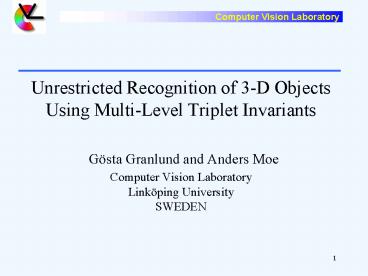Unrestricted Recognition of 3-D Objects Using Multi-Level Triplet Invariants G - PowerPoint PPT Presentation
1 / 42
Title:
Unrestricted Recognition of 3-D Objects Using Multi-Level Triplet Invariants G
Description:
Unrestricted Recognition of 3-D Objects Using Multi-Level Triplet Invariants G sta Granlund and Anders Moe Computer Vision Laboratory Link ping University – PowerPoint PPT presentation
Number of Views:170
Avg rating:3.0/5.0
Title: Unrestricted Recognition of 3-D Objects Using Multi-Level Triplet Invariants G
1
Unrestricted Recognition of 3-D Objects Using
Multi-Level Triplet Invariants Gösta Granlund
and Anders MoeComputer Vision LaboratoryLinköpin
g UniversitySWEDEN
2
By unrestricted, we imply that the recognition
shall be done independently of object position,
scale, orientation and pose, against a structured
background. It shall not assume any preceding
segmentation and allow a reasonable degree of
occlusion.
3
Traditional approach
4
Object Representation
5
Object Parameters
Var Object characterization
? Object class
x Horisontal position of object
y Vertical position of object
Horisontal pose angle of object
? Vertical pose angle of object
? Orientation of object in image plane
s Scale or size of object
6
Object Identification -- An Inverse Problem
- Implies a two-step process
- Postulation of a certain model
- Performing measurements, and comparing these with
a reference, under the assumption of the
particular model
7
Requirements of Model Structure
- Models shall be fragmentable such that a certain
model can be part of a more complex or higher
order model. Due to this recursive character, we
will simply denote them all models, be it parts
or combinations. - Learning of models shall proceed from lower
levels to higher levels. - Acquired lower level models shall be usable as
parts of several different higher order models. - A particular model is only acquired once, and its
first occurrence is used as the representation of
that model.
8
Invariance to illumination
9
Local versus global properties
10
Conflicting interpretations
11
Object Representation
12
Compact description of regions
13
Edges and lines
14
Curvature, corners I
15
Curvature, corners II
16
Triplet Models
17
Multi-level Triplet Models
18
Properties of Triplet Structure
- It allows a unique ordering of the feature
points, which is implemented such that the
triplet is right oriented, i.e. that the angle
a lt p. - The triplet structure allows us to define a scale
invariant structure parameter - The distance between the two feature points not
connected by the triplet, must be shorter than
the two other distances between feature points. - The triplet can be brought into a normal
orientation by aligning leg to make
19
Invariance Properties
- The preceding properties together with the
hierarchical arrangement of triplets make the
following parameter variations trivial - Orientation in the image plane
- Scale
- Object position in x and y
20
Procedures
Statistics
Assumption of Structure
Preselection Grouping
21
Examples of Grouping Rules
- Spatial grouping range We expect primitives to
increase in spatial size going towards higher
levels. - Object closure criteria Tests for homogeneity
such as similar density or color inside the
triplets, to indicate parts of a common object or
region. - Symmetry
22
Channel Inform. Representation
23
Triplet Components
- A triplet can be characterized in a number of
equivalent fashions. The components used are - Point feature vectors, k1,2,3, each one
coded with hf channels. - Angle between triplet legs 1 and 2, coded
with ha channels. - Relative length of triplet legs, coded with
hg channels.
24
Triplet Vector
25
Mapping Onto Object States
26
Dynamic Binding Variables
- From the purely geometric and feature related
entities, it is desired to map into variables
that are object-related - They change as a consequence of manipulation of
the object, which is essential - They can be expected to be shared with, or at
least coupled to, other primitives at the same
level, or at a different level
27
Object States
28
Mapping from Features to Objects
29
Features for Higher Level Triplets
30
Mapping from Features to Objects
31
Consistency Check of Outputs
32
Removal of Multiple Models
33
Estimation of Object Orientation
- Orientation estimates of an object are
obtained as the difference between the observed
orientation of the higher level triplets, and
their estimates of the original orientation at
training.
34
Estimation of Scale
- Derived estimate of scale is divided by
the length of the original triplet.
35
Object Training Setup
36
Object scanner
37
Training Sequence
38
Estim. Pose, Orientation and Scale
39
Average Error for 60 Rotated and 10 Rescaled
Object in Test Set
Estimate Average Error
Pose-x 1.8
Pose-y 1.8
Orientation 6.3
Scale 4.9
40
Scaled and Occluded Object
41
Multiple, Occluded Objects
42
Estimates of Pose































